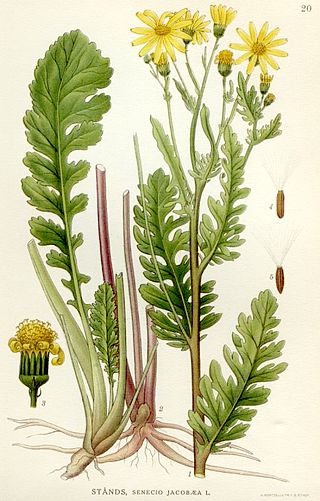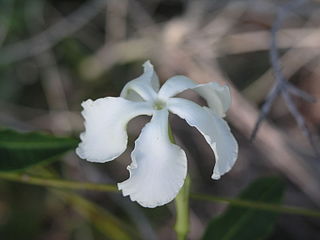
Alkaloids are a class of basic, naturally occurring organic compounds that contain at least one nitrogen atom. This group also includes some related compounds with neutral and even weakly acidic properties. Some synthetic compounds of similar structure may also be termed alkaloids. In addition to carbon, hydrogen and nitrogen, alkaloids may also contain oxygen or sulfur. More rarely still, they may contain elements such as phosphorus, chlorine, and bromine.

Jacobaea vulgaris, syn. Senecio jacobaea, is a very common wild flower in the family Asteraceae that is native to northern Eurasia, usually in dry, open places, and has also been widely distributed as a weed elsewhere.

Senecio vulgaris, often known by the common names groundsel and old-man-in-the-spring, is a flowering plant in the family Asteraceae. It is an annual herb, native to the Palaearctic and widely naturalised as a ruderal species in suitable disturbed habitats worldwide.

Crotalaria is a genus of flowering plants in the family Fabaceae commonly known as rattlepods. The genus includes over 700 species of herbaceous plants and shrubs. Africa is the continent with the majority of Crotalaria species, which are mainly found in damp grassland, especially in floodplains, depressions and along edges of swamps and rivers, but also in deciduous bush land, roadsides and fields. Some species of Crotalaria are grown as ornamentals. The common name rattlepod or rattlebox is derived from the fact that the seeds become loose in the pod as they mature, and rattle when the pod is shaken. The name derives from the Ancient Greek κρόταλον, meaning "castanet", and is the same root as the name for the rattlesnakes (Crotalus).

Borage, also known as starflower, is an annual herb in the flowering plant family Boraginaceae native to the Mediterranean region. Although the plant contains small amounts of pyrrolizidine alkaloids, some parts are edible and its seeds provide oil.

Tussilago farfara, commonly known as coltsfoot, is a plant in the tribe Senecioneae in the family Asteraceae, native to Europe and parts of western and central Asia. The name "tussilago" is derived from the Latin tussis, meaning cough, and ago, meaning to cast or to act on. It has had uses in traditional medicine, but the discovery of toxic pyrrolizidine alkaloids in the plant has resulted in liver health concerns.

Cynoglossum amabile, the Chinese hound's tongue or Chinese forget-me-not, is a species of flowering plant in the family Boraginaceae, native to Asia. A hardy annual growing to 50 cm (20 in), it has hairy leaves and cymes of sky-blue flowers in late summer. This plant, closely related to the common forget-me-not of temperate gardens, is also grown as an ornamental. In cultivation in the UK it has gained the Royal Horticultural Society's Award of Garden Merit..

Utetheisa ornatrix, also called the ornate bella moth, ornate moth, bella moth or rattlebox moth, is a moth of the subfamily Arctiinae. It is aposematically colored ranging from pink, red, orange and yellow to white coloration with black markings arranged in varying patterns on its wings. It has a wingspan of 33–46 mm. Moths reside in temperate midwestern and eastern North America as well as throughout Mexico and other parts of Central America. Unlike most moths, the bella moth is diurnal. Formerly, the bella moth or beautiful utetheisa of temperate eastern North America was separated as Utetheisa bella. Now it is united with the bella moth in Utetheisa ornatrix.

A loline alkaloid is a member of the 1-aminopyrrolizidines, which are bioactive natural products with several distinct biological and chemical features. The lolines are insecticidal and insect-deterrent compounds that are produced in grasses infected by endophytic fungal symbionts of the genus Epichloë. Lolines increase resistance of endophyte-infected grasses to insect herbivores, and may also protect the infected plants from environmental stresses such as drought and spatial competition. They are alkaloids, organic compounds containing basic nitrogen atoms. The basic chemical structure of the lolines comprises a saturated pyrrolizidine ring, a primary amine at the C-1 carbon, and an internal ether bridge—a hallmark feature of the lolines, which is uncommon in organic compounds—joining two distant ring carbons. Different substituents at the C-1 amine, such as methyl, formyl, and acetyl groups, yield loline species that have variable bioactivity against insects. Besides endophyte–grass symbionts, loline alkaloids have also been identified in some other plant species; namely, Adenocarpus species and Argyreia mollis.

Senecionine is a toxic pyrrolizidine alkaloid isolated from various botanical sources. It takes its name from the Senecio genus and is produced by many different plants in that genus, including Jacobaea vulgaris. It has also been isolated from several other plants, including Brachyglottis repanda, Emilia, Erechtites hieraciifolius, Petasites, Syneilesis, Crotalaria, Caltha leptosepala, and Castilleja.
Pyrrolizidine alkaloidosis is a disease caused by chronic poisoning found in humans and other animals caused by ingesting poisonous plants which contain the natural chemical compounds known as pyrrolizidine alkaloids. Pyrrolizidine alkaloidosis can result in damage to the liver, kidneys, heart, brain, smooth muscles, lungs, DNA, lesions all over the body, and could be a potential cause of cancer. Pyrrolizidine alkaloidosis is known by many other names such as "Pictou Disease" in Canada and "Winton Disease" in New Zealand. Cereal crops and forage crops can sometimes become polluted with pyrrolizidine-containing seeds, resulting in the alkaloids contaminating flour and other foods, including milk from cows feeding on these plants.
Pyrrolizidine alkaloid sequestration by insects is a strategy to facilitate defense and mating. Various species of insects have been known to use molecular compounds from plants for their own defense and even as their pheromones or precursors to their pheromones. A few Lepidoptera have been found to sequester chemicals from plants which they retain throughout their life and some members of Erebidae are examples of this phenomenon. Starting in the mid-twentieth century researchers investigated various members of Arctiidae, and how these insects sequester pyrrolizidine alkaloids (PAs) during their life stages, and use these chemicals as adults for pheromones or pheromone precursors. PAs are also used by members of the Arctiidae for defense against predators throughout the life of the insect.

Hair-pencils and coremata are pheromone signaling structures present in lepidopteran males. Males use hair-pencils in courtship behaviors with females. The pheromones they excrete serve as both aphrodisiacs and tranquilizers to females as well as repellents to conspecific males. Hair-pencil glands are stored inside the male until courtship begins, at which point they are forced out of the body by sclerotized levers present on the abdomen. Coremata are very similar structures. Their exact definition is confused by early descriptions but they are more specifically defined as the internal, glandular, eversible structures that bear the hair-pencils and can be voluntarily inflated with hemolymph or air.

Riddelliine is a chemical compound classified as a pyrrolizidine alkaloid. It was first isolated from Senecio riddellii and is also found in a variety of plants including Jacobaea vulgaris, Senecio vulgaris, and others plants in the genus Senecio.

Parasenecio hastatus is a flowering plant species in the genus Parasenecio found in China and East Asia. It contains toxic pyrrolizidine alkaloids.

Retronecine is a pyrrolizidine alkaloid found in a variety of plants in the genera Senecio and Crotalaria, and the family Boraginaceae. It is the most common central core for other pyrrolizidine alkaloids.

Hydroxydanaidal is an insect pheromone synthesized by some species of moth from pyrrolizidine alkaloids found in their diet.

Amabiline is a pyrrolizidine alkaloid first isolated in 1967 from Cynoglossum amabile. It is also found in the seeds and flowers of borage and in borage seed oil.

Echites umbellatus is a flowering climber, belonging to subfamily Apocynoideae of the family Apocynaceae and has the English common name devil's potato. It was first described in 1760 by Dutch botanist, Nikolaus Joseph von Jacquin. The species grows in parts of Florida, Tabasco, Yucatán Peninsula, Belize, Honduras, Cayman Islands, Cuba, Hispaniola, Jamaica, Leeward Islands, Bahamas, Turks and Caicos Islands, and the Colombian islands in the Western Caribbean.

















